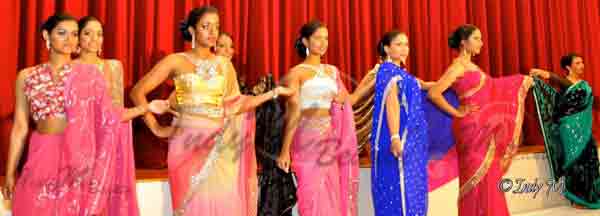Fashion in Focus
Yards And Yards Of Beauty – A peek into the how and where of the Sari
By Sharmila Jayasinghe Niriella
A garment made of an unstitched cloth measuring five to six yards in length and forty-two to forty-nine inches in width has gained much attention as a source of inspiration for fashion all over the world lately. This garment which is known as the sari or saree is no strange attire for those of us who come from “sari wearing” nations. The yards and yards of cloth that we women wrap around ourselves has a rich history dating back to the time when cotton was first cultivated and used in manufacture clothing. Though it is not clearly stated anywhere why the sari is what it is or how it is: a whole lot of cloth draped around the body, the design of the outfit could have had climate as a decider. Since this attire originated in tropical lands it would have been designed with comforts in mind but not forgetting modesty. Though there is a lot of cloth that is in play, the sari is draped in a manner to guarantee proper air circulation and coverage.
According to 6th century Pali and Sanskrit literature the sari or saree originated as a three piece attire which consisted of a lower garment (Antriya), a section worn over shoulder (Uttariya) and a chest-band (Stanapatta ). Over the centuries this attire has evolved and taken many shades, shapes and forms mostly without reducing the number of meters or yards that requires the garment to be a sari. Though these days the five or six yards are cut in to two or three pieces to form several parts of the attire or draped as a whole the dynamics of it all have not changed – the sari is still what it used to be : a whole lot of cloth wrapped around a woman’s body.
As history shows the sari was, as in modern times, draped in different styles. These differences may not have been born purely to keep up with changing fashion but more so due to cultural or social settings. The French cultural anthropologist and sari researcher Chantal Boulanger divides sari drape styles into thirteen main categories. Out of these the most common would be the Nivi style that is wildly used in modern times.
Nivi drape starts with one end of the sari tucked into the waistband of the underskirt. The cloth is then wrapped around the lower body once, then hand-gathered into even pleats below the navel. These elegant long lines of pleats create a graceful, decorative effect with every step taken. After one more turn around the waist, the loose end of the cloth which is known as the “pallu” or “fall” is then draped over the shoulder diagonally in front of the torso across the right hip to over the left shoulder. The pallu may be hanging freely, tucked in at the waist, used to cover the head, or used to cover the neck, by draping it across the right shoulder as well. The long pallu draped over the shoulder and hanging down to wrist length gives more of a sweeping vertical element, creating an instant elegance. This style, though originated in Andra Pradesh in India has become the most commonly worn sari style of many cultures today.
Another style we Sri Lankans are familiar with today and which has broken boundaries to become “everyone’s style” is the Guajarati style. Here the cloth is draped around the body in the same way as the Nivi style but the pallu or the fall is taken from the back, draped across the right shoulder, and pulled across to be secured in the back.
The Kandyan style (or Osari in Sinhalese) is the one style that is known to and is almost exclusively worn by those of Sri Lankan origin . This Kandyan style of sari drape is generally more popular in the hill country region of Kandy from which the style gets its name. The traditional Kandyan (Osari) style consists of a full blouse which covers the midriff completely. The actual style of the sari is different to Nivi style and perceived by many as a much more complicated drape. However, modern intermingling of styles has led to easier ways of draping the Kandyan style sari by separating it into three separate parts the end result being named the “made up Kandyan sari”. However it is draped, as the whole five to six yards or “made up”, in Kandyan style of draping the final tail of the sari is neatly pleated rather than free-flowing. This is rather similar to the pleated rosette used in the Dravidian style of drape. The Kandyan style of sari is considered the national dress of Sinhalese women and is the uniform of the air hostesses of Sri Lankan Airlines – the national carrier of Sri Lanka.
With the evolution of the garment, the sari has claimed its place in runways all over the world and has attracted the attention as a fascinating garment. In modern day fashion scenes the sari is accessorised with belts, fancy pins, flowers and just about everything you can imagine!
Photos Supplied by Indrani Mahanama
Saris Designs & Dressed by Indrani Mahanama
Reference: Saris by Chantal Boulanger











No Comments